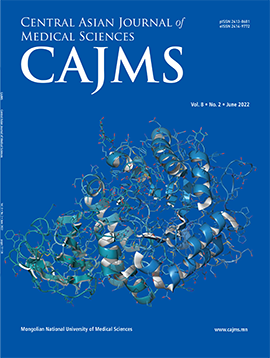Mild Ovarian Stimulation for Infertility in Women with Polycystic Ovary Syndrome
DOI:
https://doi.org/10.24079/cajms.2022.03.002Keywords:
Mild Ovarian Stimulation, Clomiphene Citrate, Polycystic Ovary SyndromeAbstract
Objective: The aim of this study was to explore the effect of clomiphene citrate (CC) on the cycle characteristics and outcomes of women with polycystic ovarian syndrome (PCOS) undergoing ovarian stimulation. Methods: This is a cross sectional study, and it was conducted at the tertiary-care medical center. This study included 55 PCOS patients and 54 patients without PCOS undergoing ovarian mild stimulation. In the study group (n = 55), CC and human menopausal gonadotropin (HMG) were administered simultaneously beginning on cycle day 3, while in the control group without PCOS (n = 54) a differing protocol treatment was used. The primary outcome measure was the stimulation day, HMG dose, number of dominant follicles, serum E2, LH, P4 in trigger day and number of oocytes. Secondary outcomes included the number of top-quality embryos, maturation rate, fertilization rate, cleavage rate, incidence of premature LH surge, and OHSS, biochemical and clinical pregnancy rate. Results: The study group received obviously a lower total HMG dose [470.54 ± 304.5 (375–975) vs. 500.00 ± 287.59 IU, but similar HMG duration. While the antral follicle count (AFC) was higher in the study group, the number of oocytes retrieved and top-quality embryos was remarkably less [5 (0 – 30) vs. 13 (0 – 42), 2 (0 –14) vs. 3.5 (0 – 15), p = 0.003, respectively]. The mature oocyte rate was higher in the study group (p = 0.036). No significant differences were detected in fertilization rate and cleavage rate between the 2 groups. CC had a positive influence (higher oocytes retrieved and top-quality embryos) on cycle characteristics, but might be correlated with the impaired IVF outcomes (lower E2, lower implantation rate) in PCOS patients undergoing IVF, when CC + HMG was used simultaneously. Conclusion: In women with PCOS, mild CC stimulation resulted in increased oocytes and viable embryos compared with the control group. The study regimens had a low incidence of OHSS. The results of the CC combined regimen provide new insights into the development of a more patient-friendly protocol for women with PCOS. However, this study needs to be continued on more samples in the future.
Downloads
283
Downloads
Published
How to Cite
Issue
Section
License
Copyright (c) 2022 Mongolian National University of Medical Sciences

This work is licensed under a Creative Commons Attribution-NonCommercial 4.0 International License.




